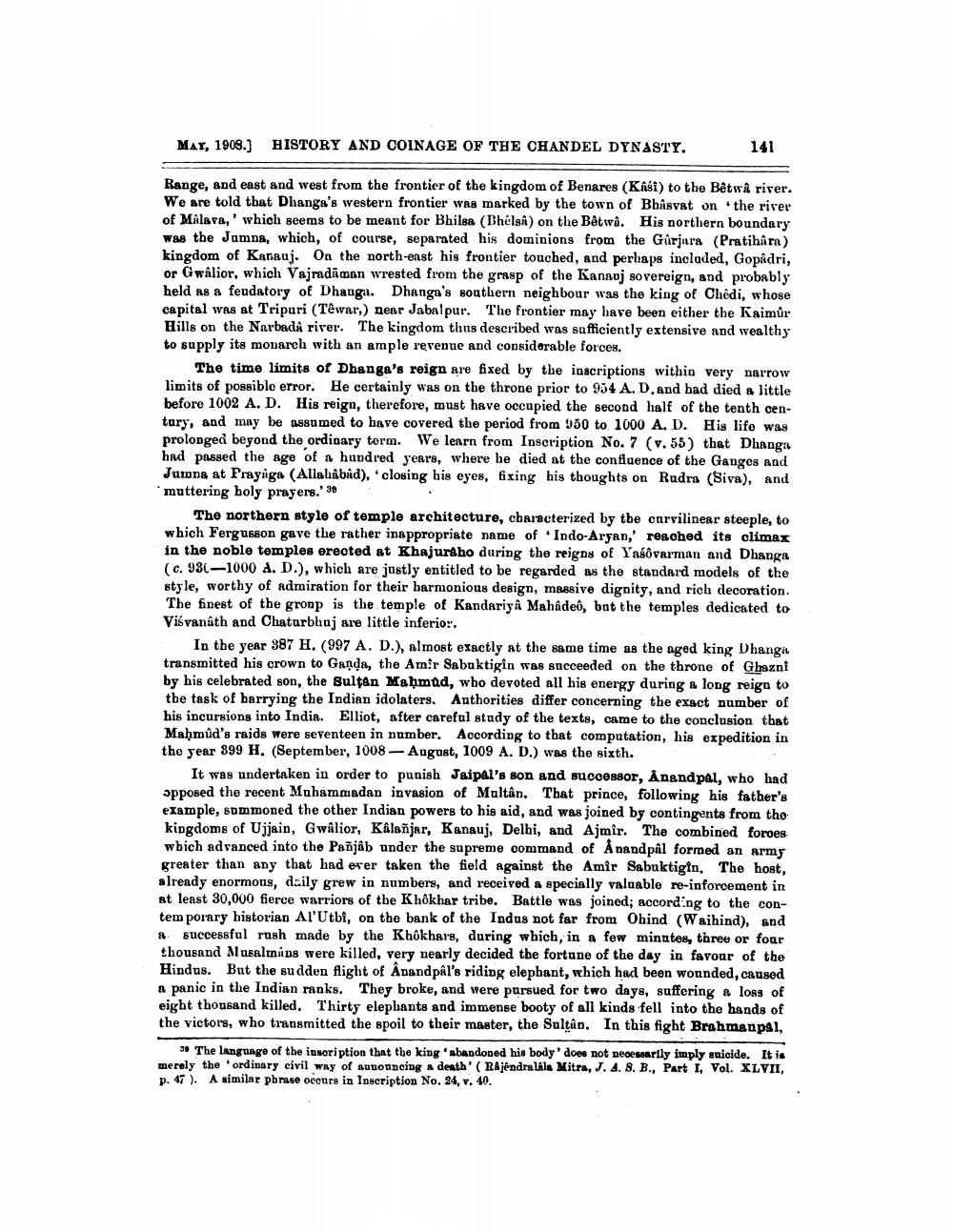________________
MAY, 1908.) HISTORY AND COINAGE OF THE CHANDEL DYNASTY.
141
Range, and east and west from the frontier of the kingdom of Benares (Kasi) to the Betwâ river. We are told that Dhanga's western frontier was marked by the town of Bhasvat on the river of Malava,' which seems to be meant for Bhilea (Bhelsi) on the Bêtwa. His northern boundary was the Jamna, which, of course, separated his dominions from the Gurjara (Pratihara) kingdom of Kanauj. On the north-east his frontier touched, and perhaps included, Gopadri, or Gwalior, which Vajradāmon wrested from the grasp of the Kanaoj sovereign, and probably held as a feudatory of Dhanga. Dhanga's southern neighbour was the king of Chedi, whose capital was at Tripuri (Têwar,) near Jabalpur. The frontier may have been either the Kaimûr Hills on the Narbada river. The kingdom thus described was sufficiently extensive and wealthy to supply its monarch with an ample revenue and considorable forces.
The time limits of Dhanga's reign are fixed by the inscriptions within very narrow limits of possiblo error. He certainly was on the throne prior to 954 A. D. and had died a little before 1002 A. D. His reigo, therefore, must have occupied the second half of the tenth centory, and may be assumed to have covered the period from 950 to 1000 A. D. His life was prolonged beyond the ordinary term. We learn from Inscription No. 7 (v. 55) that Dhanga had passed the age of a hundred years, where he died at the confluence of the Ganges and Jarong at Prayaga (Allahâbâd), closing his eyes, fixing his thoughts on Rudra (Siva), and muttering boly prayers.' 39
The northern style of temple architecture, caracterized by the curvilinear steeple, to which Fergusson gave the rather inappropriate name of Indo-Aryan,' reached its climax in the noble temples erected at Khajuraho during the reigns of Yasovarman and Dhanga (c. 931-1000 A.D.), which are justly entitled to be regarded as the standard models of the style, worthy of admiration for their harmonious design, massive dignity, and rich decoration. The finest of the gronp is the temple of Kandariya Mahadeô, bat the temples dedicated to Visvanath and Chaturbhuj are little inferior.
In the year 387 H. (997 A. D.), almost exactly at the same time as the aged king Dhanga transmitted his crown to Ganda, the Amir Sabaktigin was succeeded on the throne of Ghazni by his celebrated son, the Sultan Mahmud, who devoted all his energy during a long reign to the task of barrying the Indian idolaters. Authorities differ concerning the exact number of his incursions into India. Elliot, after careful stady of the texts, came to the conclusion that Mahmud's raids were seventeen in number. According to that computation, his expedition in the year 899 H. (September, 1008 - August, 1009 A. D.) was the sixth.
It was undertaken in order to punish Jaipal's son and successor, Anandpal, who had apposed the recent Muhammadan invasion of Multân. That prince, following his father's example, summoned the other Indian powers to his aid, and was joined by contingents from tho kingdoms of Ujjain, Gwalior, Kalañjar, Kanauj, Delhi, and Ajmir. The combined foroes which advanced into the Pañjab under the supreme command of Anandpal formed an army greater than any that had ever taken the field against the Amir Sabuktigin. The host, already enormons, daily grew in numbers, and received a specially valuable re-inforcement in at least 30,000 fierce warriors of the Khokhar tribe. Battle was joined; according to the contemporary historian Al'Utbi, on the bank of the Indus not far from Ohind (Waihind), and # successful rush made by the Khokhars, during which, in a few minutes, three or four thousand Muealtnins were killed, very nearly decided the fortune of the day in favour of the Hindus. But the sudden flight of Anandpal's riding elephant, which had been wonnded, caused a panic in the Indian ranks. They broke, and were pursued for two days, suffering a loss of eight thousand killed. Thirty elephants and immense booty of all kinds fell into the hands of the victors, who transmitted the spoil to their master, the Sultân. In this fight Brahmanpai,
» The language of the inscription that the king 'abandoned his body does not necessarily imply suicide. It is merely the ordinary civil way of sunouncing a death' ( Rajendralala Mitra, J. A. 8. B., Part I, Vol. XLVII, p. 47). A similar phrase occurs in Inscription No. 24, v. 40.




